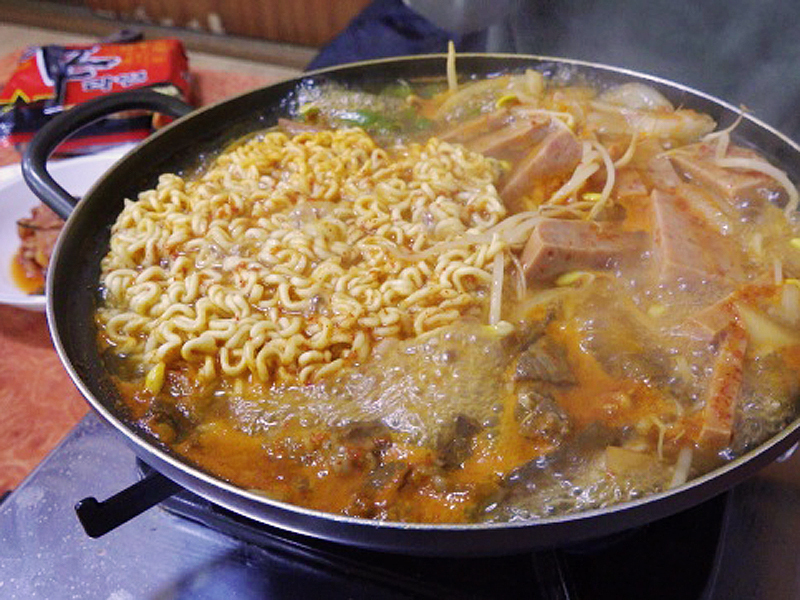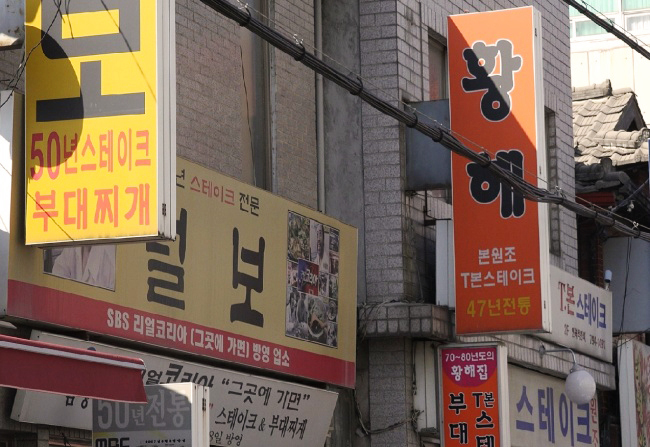[Seoul Food Alley] ‘Army stew’ represents tumultuous mid-20th century history
By Im Eun-byelPublished : May 8, 2019 - 17:26
Seoul’s alleys are filled with eateries specializing in particular dishes. The Korea Herald takes you on a foodie trip to narrow alleys where decades-old establishments beckon diners with their secret recipes, often handed down through generations. - Ed.
Though its name can be translated to “army stew” in English, the official translation of budaejjigae, approved by the Korean Food Foundation, is actually sausage stew.
The dish features more than just sausages, however, being a fusion of Korean-style spicy stew with foreign ingredients. For instance, ham and salami are often thrown into the spicy dish for a hearty meal-in-a-pot loved by many Koreans, regardless of age.
Though its name can be translated to “army stew” in English, the official translation of budaejjigae, approved by the Korean Food Foundation, is actually sausage stew.
The dish features more than just sausages, however, being a fusion of Korean-style spicy stew with foreign ingredients. For instance, ham and salami are often thrown into the spicy dish for a hearty meal-in-a-pot loved by many Koreans, regardless of age.
Budaejjigae is easily paired with soju, and you can add ramen noodles to the dish. The noodles, however, make the broth thicker.
The dish has a somewhat sad origin. After the Korean War, when food was scarce, people scavenged for leftover food dumped out from the US Army bases. Mixing everything edible they could get their hands on, budaejjigae was born, which was called “pig stew” or “UN stew” at the time.


Reflective of its origin, there are budaejjigae alleys near the US Army bases. For instance, the city of Uijeongbu, an hour‘s drive north of central Seoul, is famous for its cluster of budaejjigae restaurants. It is almost like a town of budaejjigae eateries.
But you do not have leave Seoul to indulge in an authentic budaejjigae experience. There is another budaejjigae street near Sookmyung Women’s University Station, next to the Yongsan US Army Base.
Like any other food clusters in Korea, one successful restaurant shaped the trend, paving the way for others to open similar restaurants in the area. There are now seven restaurants serving the the stew in the alley.
The restaurants here are known for serving old-fashioned Korean-style steak, dressed with mayonnaise and ketchup. But this dish has gone out of fashion, as diners look for more “authentic” steak.
Office workers in the area visit the restaurants for a hearty meal of budaejjigae priced at around 9,000 won ($7.70) per person. But during dinner hours, there are also groups of seniors who meet for steak, recalling their younger days.
By Im Eun-byel (silverstar@heraldcorp.com)











![[Today’s K-pop] BTS pop-up event to come to Seoul](http://res.heraldm.com/phpwas/restmb_idxmake.php?idx=644&simg=/content/image/2024/04/17/20240417050734_0.jpg&u=)





![[KH Explains] Hyundai's full hybrid edge to pay off amid slow transition to pure EVs](http://res.heraldm.com/phpwas/restmb_idxmake.php?idx=652&simg=/content/image/2024/04/18/20240418050645_0.jpg&u=20240419100350)

![[Today’s K-pop] Zico drops snippet of collaboration with Jennie](http://res.heraldm.com/phpwas/restmb_idxmake.php?idx=642&simg=/content/image/2024/04/18/20240418050702_0.jpg&u=)